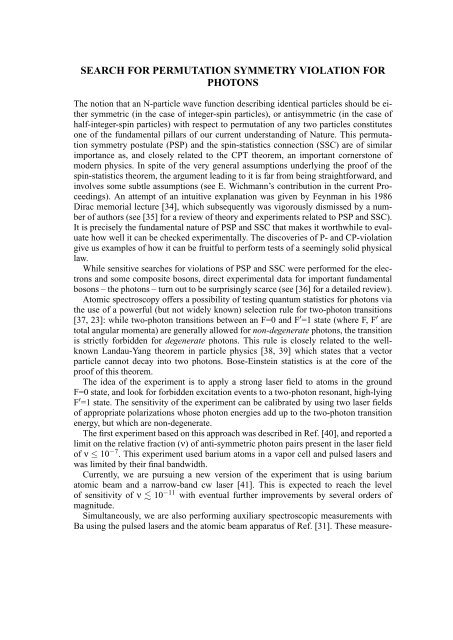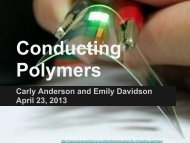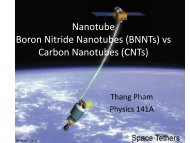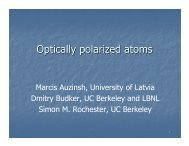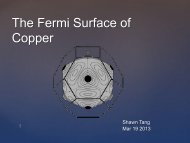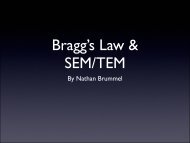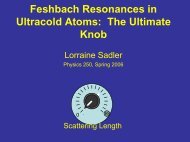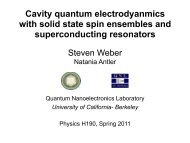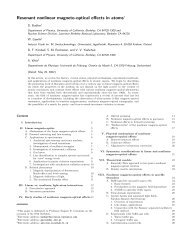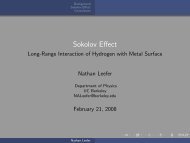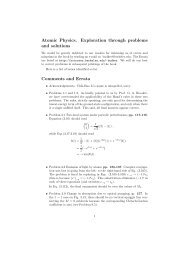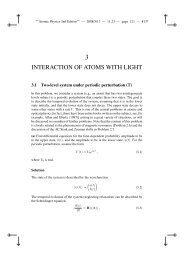Atomic Tests of Discrete Symmetries at Berkeley - The Budker Group
Atomic Tests of Discrete Symmetries at Berkeley - The Budker Group
Atomic Tests of Discrete Symmetries at Berkeley - The Budker Group
Create successful ePaper yourself
Turn your PDF publications into a flip-book with our unique Google optimized e-Paper software.
SEARCH FOR PERMUTATION SYMMETRY VIOLATION FOR<br />
PHOTONS<br />
<strong>The</strong> notion th<strong>at</strong> an N-particle wave function describing identical particles should be either<br />
symmetric (in the case <strong>of</strong> integer-spin particles), or antisymmetric (in the case <strong>of</strong><br />
half-integer-spin particles) with respect to permut<strong>at</strong>ion <strong>of</strong> any two particles constitutes<br />
one <strong>of</strong> the fundamental pillars <strong>of</strong> our current understanding <strong>of</strong> N<strong>at</strong>ure. This permut<strong>at</strong>ion<br />
symmetry postul<strong>at</strong>e (PSP) and the spin-st<strong>at</strong>istics connection (SSC) are <strong>of</strong> similar<br />
importance as, and closely rel<strong>at</strong>ed to the CPT theorem, an important cornerstone <strong>of</strong><br />
modern physics. In spite <strong>of</strong> the very general assumptions underlying the pro<strong>of</strong> <strong>of</strong> the<br />
spin-st<strong>at</strong>istics theorem, the argument leading to it is far from being straightforward, and<br />
involves some subtle assumptions (see E. Wichmann’s contribution in the current Proceedings).<br />
An <strong>at</strong>tempt <strong>of</strong> an intuitive explan<strong>at</strong>ion was given by Feynman in his 1986<br />
Dirac memorial lecture [34], which subsequently was vigorously dismissed by a number<br />
<strong>of</strong> authors (see [35] for a review <strong>of</strong> theory and experiments rel<strong>at</strong>ed to PSP and SSC).<br />
It is precisely the fundamental n<strong>at</strong>ure <strong>of</strong> PSP and SSC th<strong>at</strong> makes it worthwhile to evalu<strong>at</strong>e<br />
how well it can be checked experimentally. <strong>The</strong> discoveries <strong>of</strong> P- and CP-viol<strong>at</strong>ion<br />
give us examples <strong>of</strong> how it can be fruitful to perform tests <strong>of</strong> a seemingly solid physical<br />
law.<br />
While sensitive searches for viol<strong>at</strong>ions <strong>of</strong> PSP and SSC were performed for the electrons<br />
and some composite bosons, direct experimental d<strong>at</strong>a for important fundamental<br />
bosons – the photons – turn out to be surprisingly scarce (see [36] for a detailed review).<br />
<strong>Atomic</strong> spectroscopy <strong>of</strong>fers a possibility <strong>of</strong> testing quantum st<strong>at</strong>istics for photons via<br />
the use <strong>of</strong> a powerful (but not widely known) selection rule for two-photon transitions<br />
[37, 23]: while two-photon transitions between an F=0 and F ′ =1 st<strong>at</strong>e (where F, F ′ are<br />
total angular momenta) are generally allowed for non-degener<strong>at</strong>e photons, the transition<br />
is strictly forbidden for degener<strong>at</strong>e photons. This rule is closely rel<strong>at</strong>ed to the wellknown<br />
Landau-Yang theorem in particle physics [38, 39] which st<strong>at</strong>es th<strong>at</strong> a vector<br />
particle cannot decay into two photons. Bose-Einstein st<strong>at</strong>istics is <strong>at</strong> the core <strong>of</strong> the<br />
pro<strong>of</strong> <strong>of</strong> this theorem.<br />
<strong>The</strong> idea <strong>of</strong> the experiment is to apply a strong laser field to <strong>at</strong>oms in the ground<br />
F=0 st<strong>at</strong>e, and look for forbidden excit<strong>at</strong>ion events to a two-photon resonant, high-lying<br />
F ′ =1 st<strong>at</strong>e. <strong>The</strong> sensitivity <strong>of</strong> the experiment can be calibr<strong>at</strong>ed by using two laser fields<br />
<strong>of</strong> appropri<strong>at</strong>e polariz<strong>at</strong>ions whose photon energies add up to the two-photon transition<br />
energy, but which are non-degener<strong>at</strong>e.<br />
<strong>The</strong> first experiment based on this approach was described in Ref. [40], and reported a<br />
limit on the rel<strong>at</strong>ive fraction (ν) <strong>of</strong> anti-symmetric photon pairs present in the laser field<br />
<strong>of</strong> ν ≤ 10 −7 . This experiment used barium <strong>at</strong>oms in a vapor cell and pulsed lasers and<br />
was limited by their final bandwidth.<br />
Currently, we are pursuing a new version <strong>of</strong> the experiment th<strong>at</strong> is using barium<br />
<strong>at</strong>omic beam and a narrow-band cw laser [41]. This is expected to reach the level<br />
<strong>of</strong> sensitivity <strong>of</strong> ν 10 −11 with eventual further improvements by several orders <strong>of</strong><br />
magnitude.<br />
Simultaneously, we are also performing auxiliary spectroscopic measurements with<br />
Ba using the pulsed lasers and the <strong>at</strong>omic beam appar<strong>at</strong>us <strong>of</strong> Ref. [31]. <strong>The</strong>se measure-


